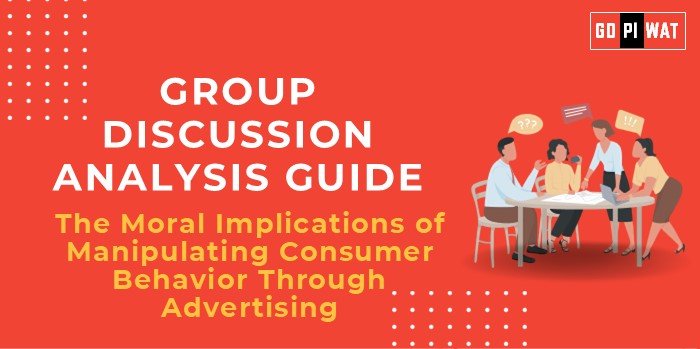📋 Group Discussion (GD) Analysis Guide
🌐 The Moral Implications of Manipulating Consumer Behavior Through Advertising
🌟 Introduction to the Topic
Opening Context: “The omnipresence of advertising shapes modern consumer behavior, raising ethical dilemmas about how far companies should go to influence decisions.”
Topic Background: Consumer manipulation in advertising employs tactics like emotional appeal, subliminal messaging, and data-driven personalization. With global ad spend surpassing $600 billion annually, the ethical implications of these methods warrant scrutiny.
📊 Quick Facts and Key Statistics
- Global Ad Spend: $665 billion (2023) – Highlights advertising’s massive scale and influence.
- Personalized Advertising: 71% of consumers prefer ads tailored to their interests, revealing the power of data-driven targeting.
- Youth Exposure: Kids aged 8-12 see over 40,000 ads yearly, raising ethical concerns about their vulnerability.
- Regulatory Challenges: Only 20% of countries have strict advertising ethics codes, highlighting the governance gap.
👥 Stakeholders and Their Roles
- Companies: Innovate and deploy advertising strategies, often pushing ethical boundaries.
- Consumers: Beneficiaries or victims of manipulation, with varying degrees of awareness.
- Governments: Enforce advertising laws and protect consumer rights.
- Media Platforms: Act as intermediaries, profiting from ad revenues while shaping societal norms.
🏆 Achievements and Challenges
- Achievements:
- Economic Growth: Advertising drives global economies, contributing $3.5 trillion in 2023.
- Consumer Awareness: Ethical advertising can educate, such as health campaigns reducing smoking rates.
- Innovation: Personalization enhances user experience, driving efficiency in consumer choices.
- Challenges:
- Exploitation of Vulnerabilities: Subliminal messages or fear-based tactics can exploit consumers.
- Data Privacy Breaches: Misuse of consumer data undermines trust and security.
- Youth Targeting: Ethical debates over advertisements influencing children’s dietary habits.
📊 Global Comparisons
- United States: Stringent FTC regulations counter deceptive advertising.
- Sweden: Prohibits advertising to children under 12, showcasing a balanced ethical approach.
📌 Case Studies
Cambridge Analytica Scandal: Highlighted manipulation through political ads using psychographic profiling.
💬 Structured Arguments for Discussion
- Supporting Stance: “Advertising fosters informed decision-making and supports economic growth.”
- Opposing Stance: “Consumer manipulation in ads undermines autonomy and exploits vulnerabilities.”
- Balanced Perspective: “Ethical advertising is achievable through regulation, ensuring economic and societal benefits.”
🛠️ Effective Discussion Approaches
- Opening Approaches:
- Use a startling statistic: “An average consumer sees 5,000 ads daily; are they truly free to choose?”
- Leverage ethical quotes: “With great power comes great responsibility—does advertising fulfill it?”
- Counter-Argument Handling:
- Address data misuse by suggesting improved encryption and opt-in policies.
🔍 Strategic Analysis of Strengths and Weaknesses
- Strengths: Drives economic activity; encourages innovation; enhances consumer choice.
- Weaknesses: Invades privacy; fosters unhealthy consumption; exploits vulnerable groups.
- Opportunities: Ethical advertising models; AI-based transparency tools.
- Threats: Rising consumer distrust; stricter regulations affecting ad profitability.
🌐 Connecting with B-School Applications
- Real-World Applications: Topics like marketing ethics and data privacy align with MBA courses on CSR and digital transformation.
- Sample Interview Questions:
- “How can businesses balance profitability with ethical advertising?”
- “What role do governments play in regulating manipulative advertising practices?”
- Insights for Students:
- Use case studies to understand regulatory frameworks.
- Explore tech innovations like blockchain for ethical advertising.


